MGT600: Evaluating People Management in Organizations Report
VerifiedAdded on 2022/09/16
|7
|1589
|23
Report
AI Summary
This report provides an analysis of people management within an organizational context, drawing upon the student's experience in the industrial chemicals sector. It explores various theories and concepts, emphasizing the importance of organizational behavior, human resource management, and the interplay between individual and group dynamics. The report examines how employee behavior, influenced by factors like personality and values, affects organizational culture and overall performance. It also discusses performance development, motivation, and the significance of effective leadership in fostering a healthy organizational culture. The report further critiques communication styles, identifies strengths and weaknesses of a presentation on the topic, and offers recommendations for improvement, particularly concerning team dynamics and leadership strategies in diverse work environments. Finally, it concludes with the importance of innovative human management for organizational success.
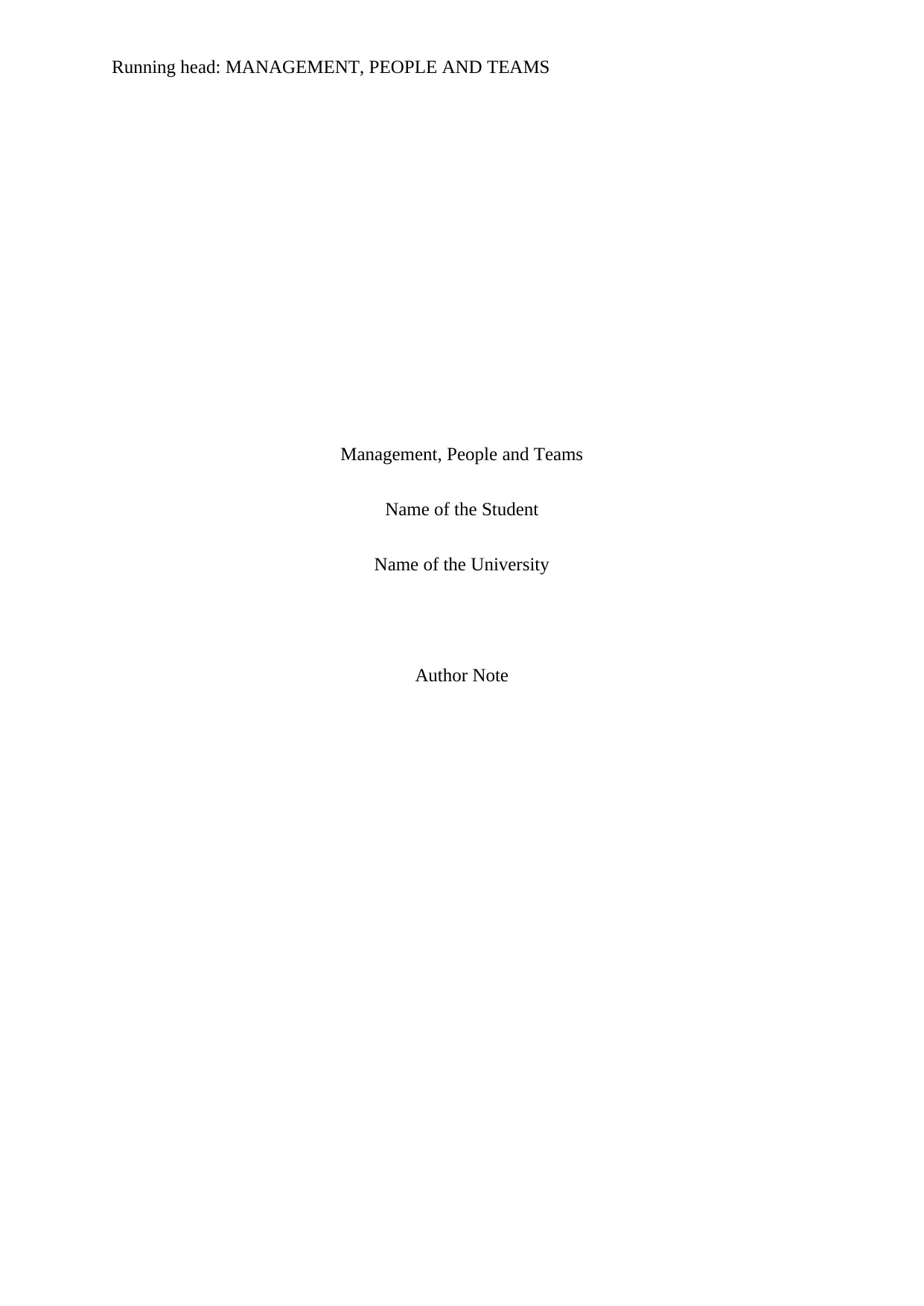
Running head: MANAGEMENT, PEOPLE AND TEAMS
Management, People and Teams
Name of the Student
Name of the University
Author Note
Management, People and Teams
Name of the Student
Name of the University
Author Note
Paraphrase This Document
Need a fresh take? Get an instant paraphrase of this document with our AI Paraphraser
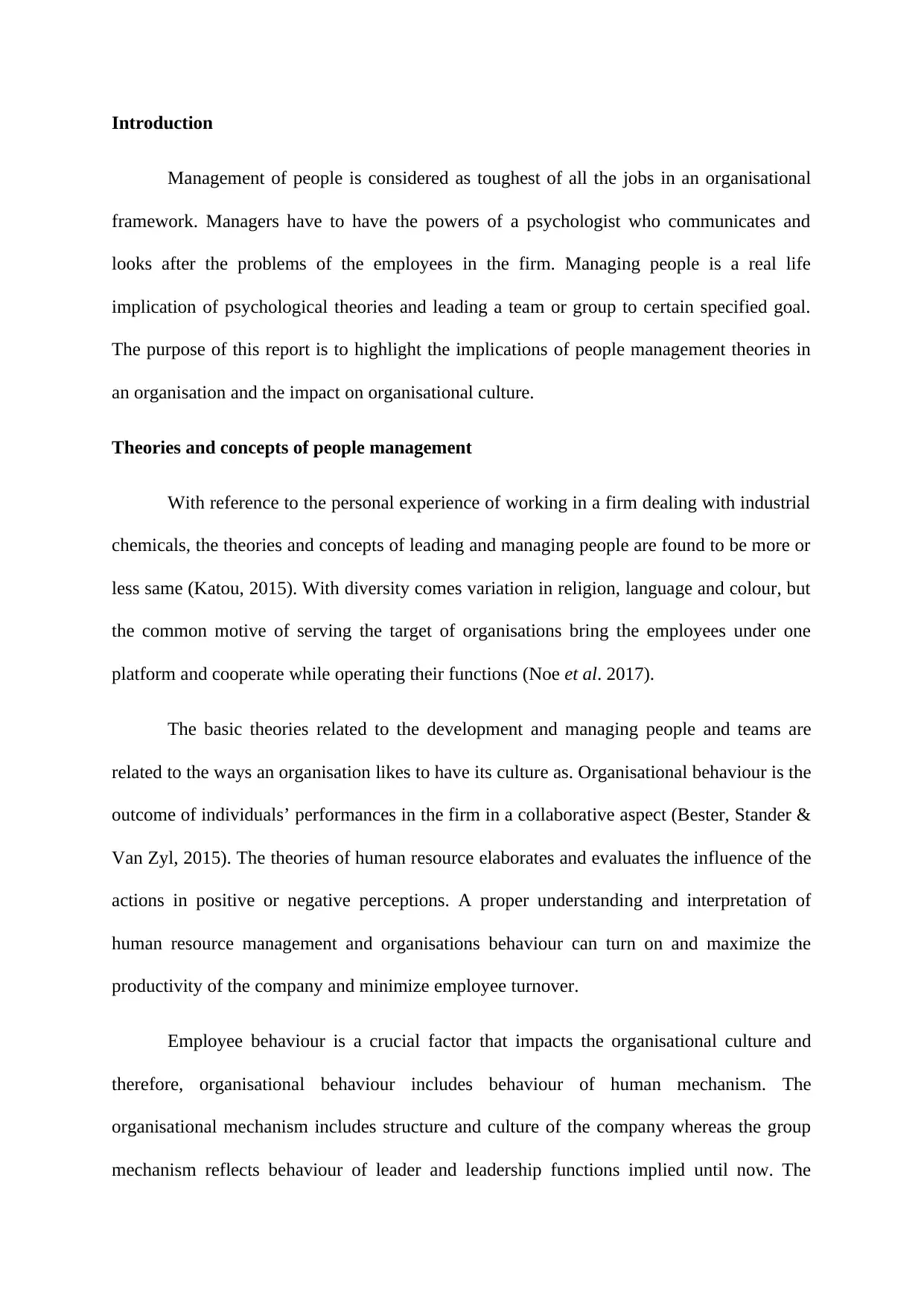
Introduction
Management of people is considered as toughest of all the jobs in an organisational
framework. Managers have to have the powers of a psychologist who communicates and
looks after the problems of the employees in the firm. Managing people is a real life
implication of psychological theories and leading a team or group to certain specified goal.
The purpose of this report is to highlight the implications of people management theories in
an organisation and the impact on organisational culture.
Theories and concepts of people management
With reference to the personal experience of working in a firm dealing with industrial
chemicals, the theories and concepts of leading and managing people are found to be more or
less same (Katou, 2015). With diversity comes variation in religion, language and colour, but
the common motive of serving the target of organisations bring the employees under one
platform and cooperate while operating their functions (Noe et al. 2017).
The basic theories related to the development and managing people and teams are
related to the ways an organisation likes to have its culture as. Organisational behaviour is the
outcome of individuals’ performances in the firm in a collaborative aspect (Bester, Stander &
Van Zyl, 2015). The theories of human resource elaborates and evaluates the influence of the
actions in positive or negative perceptions. A proper understanding and interpretation of
human resource management and organisations behaviour can turn on and maximize the
productivity of the company and minimize employee turnover.
Employee behaviour is a crucial factor that impacts the organisational culture and
therefore, organisational behaviour includes behaviour of human mechanism. The
organisational mechanism includes structure and culture of the company whereas the group
mechanism reflects behaviour of leader and leadership functions implied until now. The
Management of people is considered as toughest of all the jobs in an organisational
framework. Managers have to have the powers of a psychologist who communicates and
looks after the problems of the employees in the firm. Managing people is a real life
implication of psychological theories and leading a team or group to certain specified goal.
The purpose of this report is to highlight the implications of people management theories in
an organisation and the impact on organisational culture.
Theories and concepts of people management
With reference to the personal experience of working in a firm dealing with industrial
chemicals, the theories and concepts of leading and managing people are found to be more or
less same (Katou, 2015). With diversity comes variation in religion, language and colour, but
the common motive of serving the target of organisations bring the employees under one
platform and cooperate while operating their functions (Noe et al. 2017).
The basic theories related to the development and managing people and teams are
related to the ways an organisation likes to have its culture as. Organisational behaviour is the
outcome of individuals’ performances in the firm in a collaborative aspect (Bester, Stander &
Van Zyl, 2015). The theories of human resource elaborates and evaluates the influence of the
actions in positive or negative perceptions. A proper understanding and interpretation of
human resource management and organisations behaviour can turn on and maximize the
productivity of the company and minimize employee turnover.
Employee behaviour is a crucial factor that impacts the organisational culture and
therefore, organisational behaviour includes behaviour of human mechanism. The
organisational mechanism includes structure and culture of the company whereas the group
mechanism reflects behaviour of leader and leadership functions implied until now. The
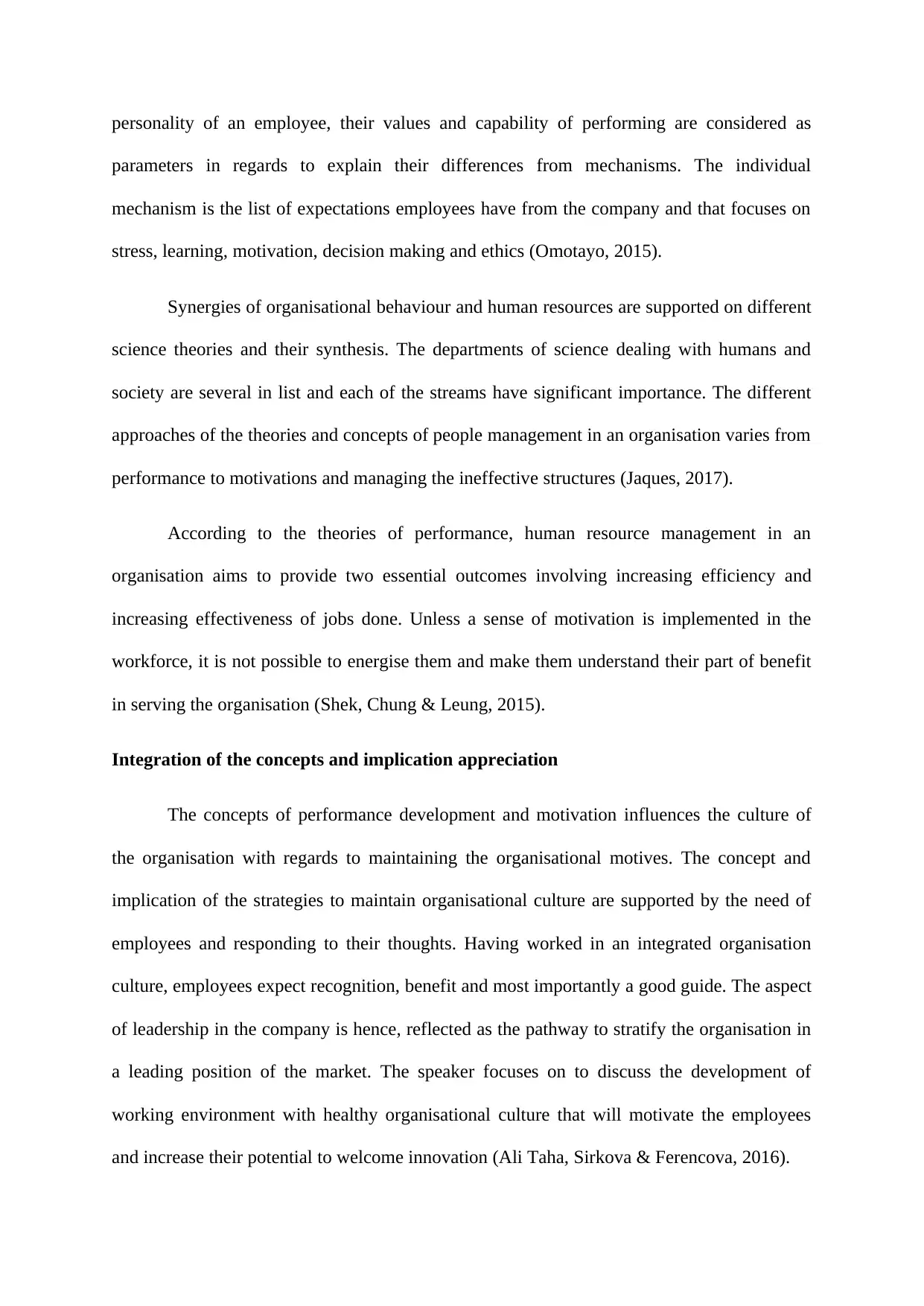
personality of an employee, their values and capability of performing are considered as
parameters in regards to explain their differences from mechanisms. The individual
mechanism is the list of expectations employees have from the company and that focuses on
stress, learning, motivation, decision making and ethics (Omotayo, 2015).
Synergies of organisational behaviour and human resources are supported on different
science theories and their synthesis. The departments of science dealing with humans and
society are several in list and each of the streams have significant importance. The different
approaches of the theories and concepts of people management in an organisation varies from
performance to motivations and managing the ineffective structures (Jaques, 2017).
According to the theories of performance, human resource management in an
organisation aims to provide two essential outcomes involving increasing efficiency and
increasing effectiveness of jobs done. Unless a sense of motivation is implemented in the
workforce, it is not possible to energise them and make them understand their part of benefit
in serving the organisation (Shek, Chung & Leung, 2015).
Integration of the concepts and implication appreciation
The concepts of performance development and motivation influences the culture of
the organisation with regards to maintaining the organisational motives. The concept and
implication of the strategies to maintain organisational culture are supported by the need of
employees and responding to their thoughts. Having worked in an integrated organisation
culture, employees expect recognition, benefit and most importantly a good guide. The aspect
of leadership in the company is hence, reflected as the pathway to stratify the organisation in
a leading position of the market. The speaker focuses on to discuss the development of
working environment with healthy organisational culture that will motivate the employees
and increase their potential to welcome innovation (Ali Taha, Sirkova & Ferencova, 2016).
parameters in regards to explain their differences from mechanisms. The individual
mechanism is the list of expectations employees have from the company and that focuses on
stress, learning, motivation, decision making and ethics (Omotayo, 2015).
Synergies of organisational behaviour and human resources are supported on different
science theories and their synthesis. The departments of science dealing with humans and
society are several in list and each of the streams have significant importance. The different
approaches of the theories and concepts of people management in an organisation varies from
performance to motivations and managing the ineffective structures (Jaques, 2017).
According to the theories of performance, human resource management in an
organisation aims to provide two essential outcomes involving increasing efficiency and
increasing effectiveness of jobs done. Unless a sense of motivation is implemented in the
workforce, it is not possible to energise them and make them understand their part of benefit
in serving the organisation (Shek, Chung & Leung, 2015).
Integration of the concepts and implication appreciation
The concepts of performance development and motivation influences the culture of
the organisation with regards to maintaining the organisational motives. The concept and
implication of the strategies to maintain organisational culture are supported by the need of
employees and responding to their thoughts. Having worked in an integrated organisation
culture, employees expect recognition, benefit and most importantly a good guide. The aspect
of leadership in the company is hence, reflected as the pathway to stratify the organisation in
a leading position of the market. The speaker focuses on to discuss the development of
working environment with healthy organisational culture that will motivate the employees
and increase their potential to welcome innovation (Ali Taha, Sirkova & Ferencova, 2016).
⊘ This is a preview!⊘
Do you want full access?
Subscribe today to unlock all pages.

Trusted by 1+ million students worldwide
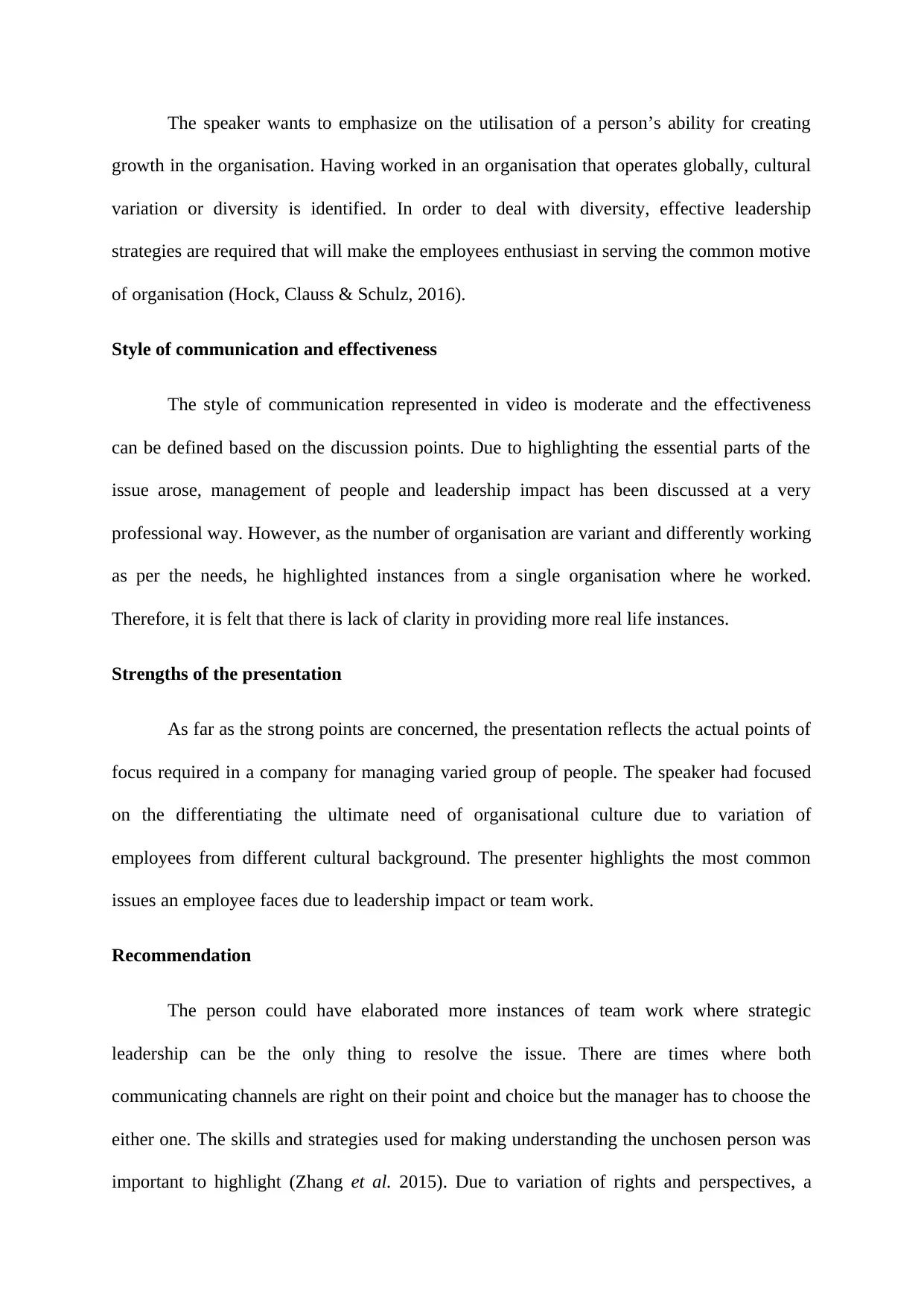
The speaker wants to emphasize on the utilisation of a person’s ability for creating
growth in the organisation. Having worked in an organisation that operates globally, cultural
variation or diversity is identified. In order to deal with diversity, effective leadership
strategies are required that will make the employees enthusiast in serving the common motive
of organisation (Hock, Clauss & Schulz, 2016).
Style of communication and effectiveness
The style of communication represented in video is moderate and the effectiveness
can be defined based on the discussion points. Due to highlighting the essential parts of the
issue arose, management of people and leadership impact has been discussed at a very
professional way. However, as the number of organisation are variant and differently working
as per the needs, he highlighted instances from a single organisation where he worked.
Therefore, it is felt that there is lack of clarity in providing more real life instances.
Strengths of the presentation
As far as the strong points are concerned, the presentation reflects the actual points of
focus required in a company for managing varied group of people. The speaker had focused
on the differentiating the ultimate need of organisational culture due to variation of
employees from different cultural background. The presenter highlights the most common
issues an employee faces due to leadership impact or team work.
Recommendation
The person could have elaborated more instances of team work where strategic
leadership can be the only thing to resolve the issue. There are times where both
communicating channels are right on their point and choice but the manager has to choose the
either one. The skills and strategies used for making understanding the unchosen person was
important to highlight (Zhang et al. 2015). Due to variation of rights and perspectives, a
growth in the organisation. Having worked in an organisation that operates globally, cultural
variation or diversity is identified. In order to deal with diversity, effective leadership
strategies are required that will make the employees enthusiast in serving the common motive
of organisation (Hock, Clauss & Schulz, 2016).
Style of communication and effectiveness
The style of communication represented in video is moderate and the effectiveness
can be defined based on the discussion points. Due to highlighting the essential parts of the
issue arose, management of people and leadership impact has been discussed at a very
professional way. However, as the number of organisation are variant and differently working
as per the needs, he highlighted instances from a single organisation where he worked.
Therefore, it is felt that there is lack of clarity in providing more real life instances.
Strengths of the presentation
As far as the strong points are concerned, the presentation reflects the actual points of
focus required in a company for managing varied group of people. The speaker had focused
on the differentiating the ultimate need of organisational culture due to variation of
employees from different cultural background. The presenter highlights the most common
issues an employee faces due to leadership impact or team work.
Recommendation
The person could have elaborated more instances of team work where strategic
leadership can be the only thing to resolve the issue. There are times where both
communicating channels are right on their point and choice but the manager has to choose the
either one. The skills and strategies used for making understanding the unchosen person was
important to highlight (Zhang et al. 2015). Due to variation of rights and perspectives, a
Paraphrase This Document
Need a fresh take? Get an instant paraphrase of this document with our AI Paraphraser
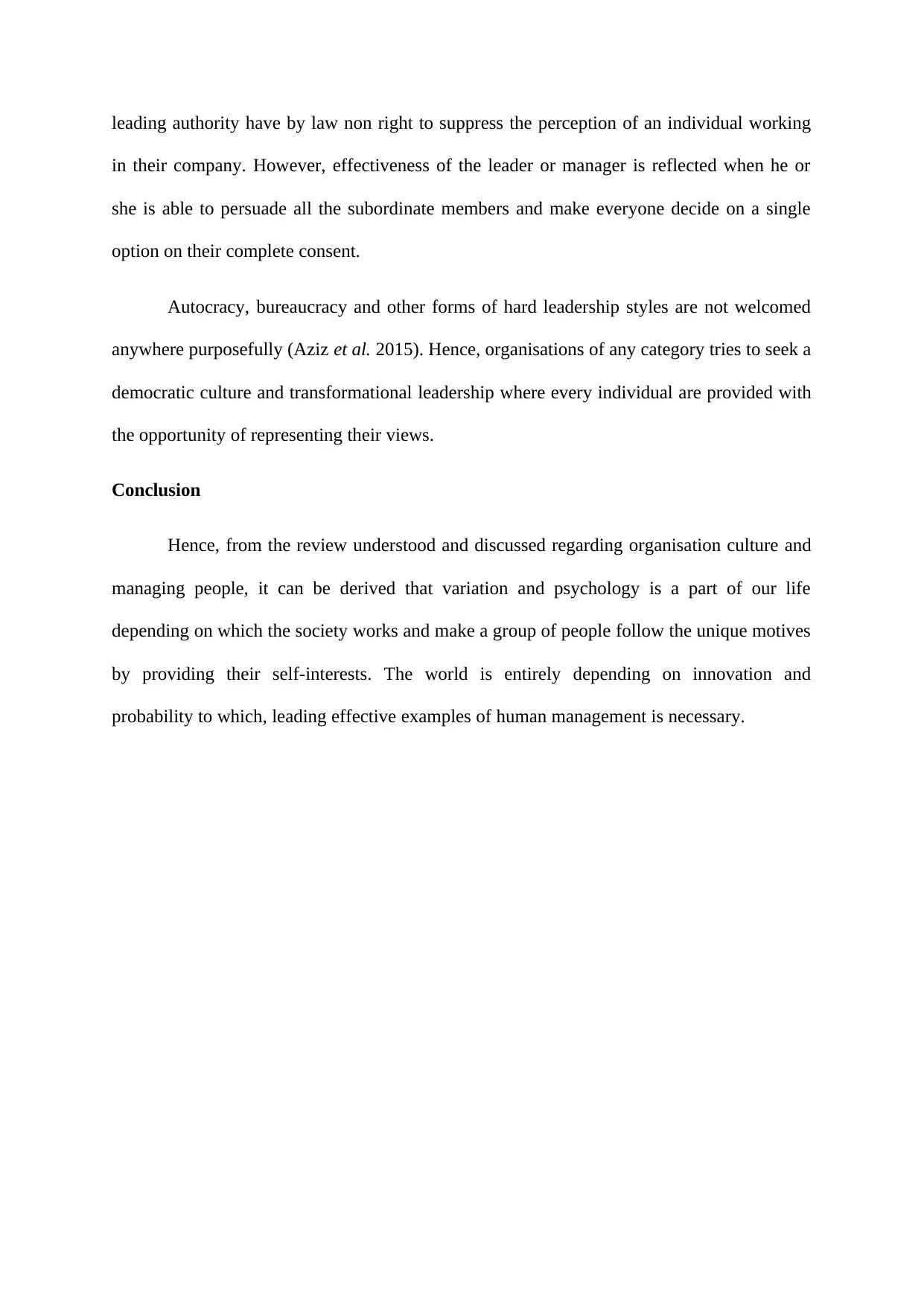
leading authority have by law non right to suppress the perception of an individual working
in their company. However, effectiveness of the leader or manager is reflected when he or
she is able to persuade all the subordinate members and make everyone decide on a single
option on their complete consent.
Autocracy, bureaucracy and other forms of hard leadership styles are not welcomed
anywhere purposefully (Aziz et al. 2015). Hence, organisations of any category tries to seek a
democratic culture and transformational leadership where every individual are provided with
the opportunity of representing their views.
Conclusion
Hence, from the review understood and discussed regarding organisation culture and
managing people, it can be derived that variation and psychology is a part of our life
depending on which the society works and make a group of people follow the unique motives
by providing their self-interests. The world is entirely depending on innovation and
probability to which, leading effective examples of human management is necessary.
in their company. However, effectiveness of the leader or manager is reflected when he or
she is able to persuade all the subordinate members and make everyone decide on a single
option on their complete consent.
Autocracy, bureaucracy and other forms of hard leadership styles are not welcomed
anywhere purposefully (Aziz et al. 2015). Hence, organisations of any category tries to seek a
democratic culture and transformational leadership where every individual are provided with
the opportunity of representing their views.
Conclusion
Hence, from the review understood and discussed regarding organisation culture and
managing people, it can be derived that variation and psychology is a part of our life
depending on which the society works and make a group of people follow the unique motives
by providing their self-interests. The world is entirely depending on innovation and
probability to which, leading effective examples of human management is necessary.
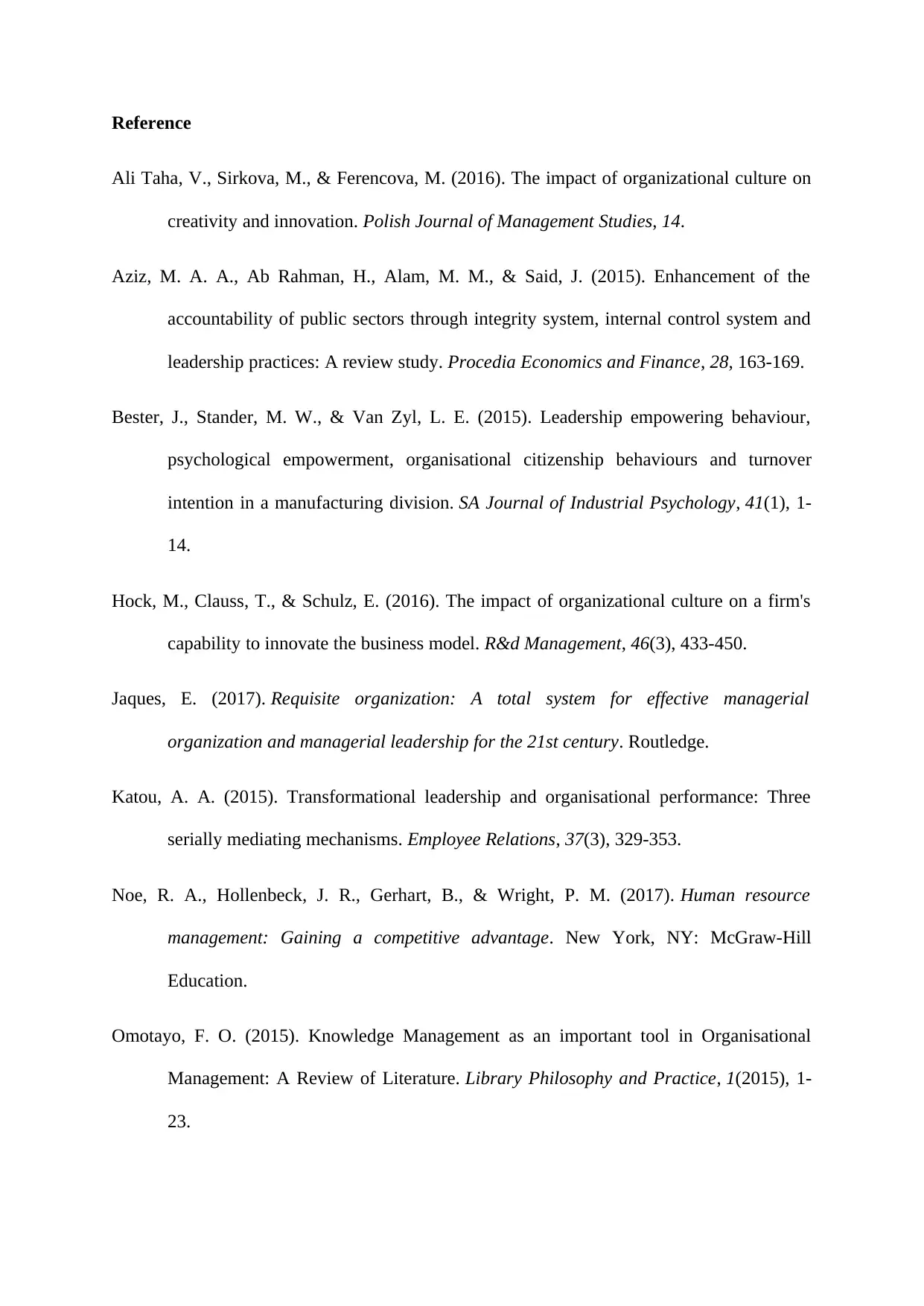
Reference
Ali Taha, V., Sirkova, M., & Ferencova, M. (2016). The impact of organizational culture on
creativity and innovation. Polish Journal of Management Studies, 14.
Aziz, M. A. A., Ab Rahman, H., Alam, M. M., & Said, J. (2015). Enhancement of the
accountability of public sectors through integrity system, internal control system and
leadership practices: A review study. Procedia Economics and Finance, 28, 163-169.
Bester, J., Stander, M. W., & Van Zyl, L. E. (2015). Leadership empowering behaviour,
psychological empowerment, organisational citizenship behaviours and turnover
intention in a manufacturing division. SA Journal of Industrial Psychology, 41(1), 1-
14.
Hock, M., Clauss, T., & Schulz, E. (2016). The impact of organizational culture on a firm's
capability to innovate the business model. R&d Management, 46(3), 433-450.
Jaques, E. (2017). Requisite organization: A total system for effective managerial
organization and managerial leadership for the 21st century. Routledge.
Katou, A. A. (2015). Transformational leadership and organisational performance: Three
serially mediating mechanisms. Employee Relations, 37(3), 329-353.
Noe, R. A., Hollenbeck, J. R., Gerhart, B., & Wright, P. M. (2017). Human resource
management: Gaining a competitive advantage. New York, NY: McGraw-Hill
Education.
Omotayo, F. O. (2015). Knowledge Management as an important tool in Organisational
Management: A Review of Literature. Library Philosophy and Practice, 1(2015), 1-
23.
Ali Taha, V., Sirkova, M., & Ferencova, M. (2016). The impact of organizational culture on
creativity and innovation. Polish Journal of Management Studies, 14.
Aziz, M. A. A., Ab Rahman, H., Alam, M. M., & Said, J. (2015). Enhancement of the
accountability of public sectors through integrity system, internal control system and
leadership practices: A review study. Procedia Economics and Finance, 28, 163-169.
Bester, J., Stander, M. W., & Van Zyl, L. E. (2015). Leadership empowering behaviour,
psychological empowerment, organisational citizenship behaviours and turnover
intention in a manufacturing division. SA Journal of Industrial Psychology, 41(1), 1-
14.
Hock, M., Clauss, T., & Schulz, E. (2016). The impact of organizational culture on a firm's
capability to innovate the business model. R&d Management, 46(3), 433-450.
Jaques, E. (2017). Requisite organization: A total system for effective managerial
organization and managerial leadership for the 21st century. Routledge.
Katou, A. A. (2015). Transformational leadership and organisational performance: Three
serially mediating mechanisms. Employee Relations, 37(3), 329-353.
Noe, R. A., Hollenbeck, J. R., Gerhart, B., & Wright, P. M. (2017). Human resource
management: Gaining a competitive advantage. New York, NY: McGraw-Hill
Education.
Omotayo, F. O. (2015). Knowledge Management as an important tool in Organisational
Management: A Review of Literature. Library Philosophy and Practice, 1(2015), 1-
23.
⊘ This is a preview!⊘
Do you want full access?
Subscribe today to unlock all pages.

Trusted by 1+ million students worldwide
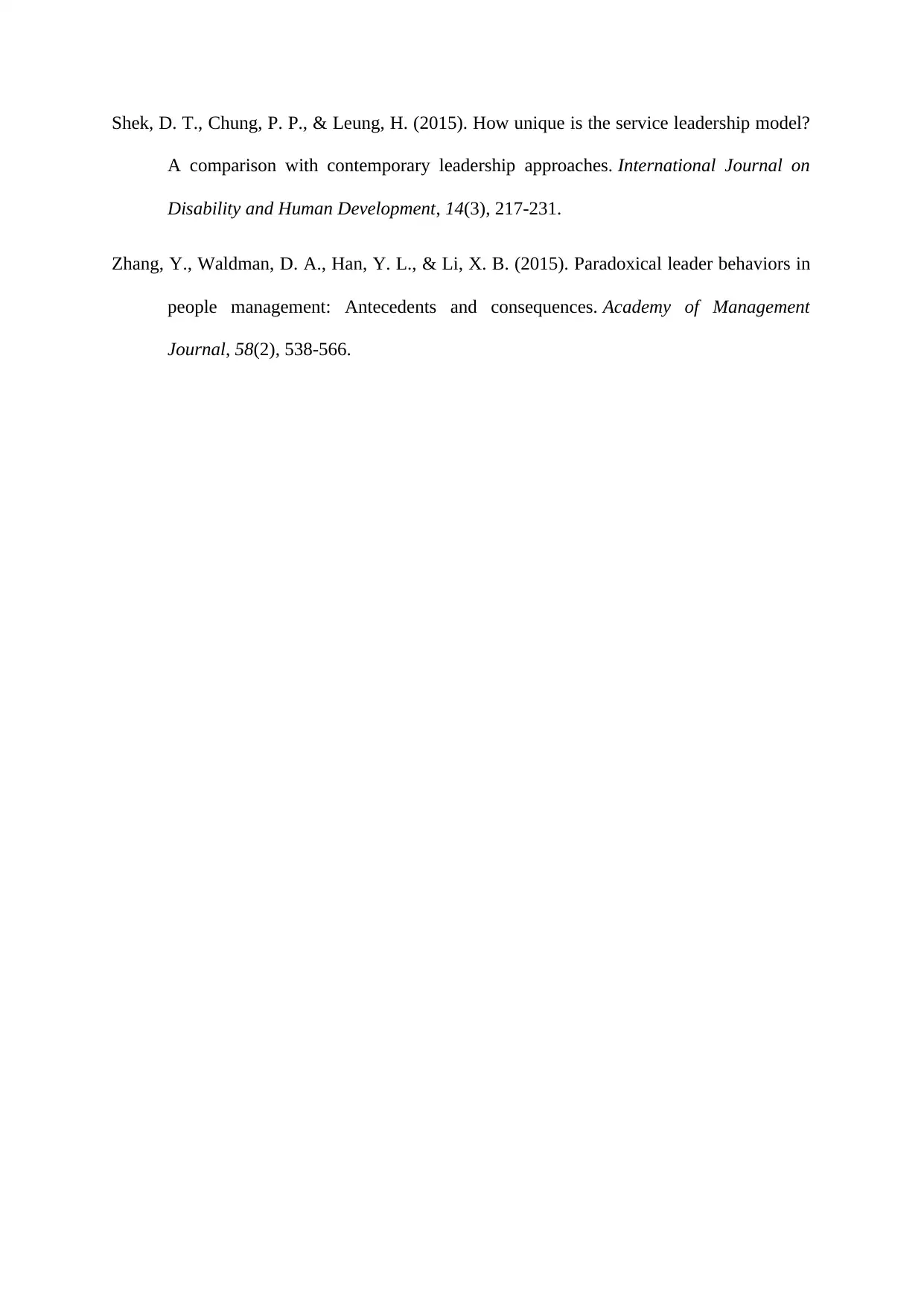
Shek, D. T., Chung, P. P., & Leung, H. (2015). How unique is the service leadership model?
A comparison with contemporary leadership approaches. International Journal on
Disability and Human Development, 14(3), 217-231.
Zhang, Y., Waldman, D. A., Han, Y. L., & Li, X. B. (2015). Paradoxical leader behaviors in
people management: Antecedents and consequences. Academy of Management
Journal, 58(2), 538-566.
A comparison with contemporary leadership approaches. International Journal on
Disability and Human Development, 14(3), 217-231.
Zhang, Y., Waldman, D. A., Han, Y. L., & Li, X. B. (2015). Paradoxical leader behaviors in
people management: Antecedents and consequences. Academy of Management
Journal, 58(2), 538-566.
1 out of 7
Related Documents
Your All-in-One AI-Powered Toolkit for Academic Success.
+13062052269
info@desklib.com
Available 24*7 on WhatsApp / Email
![[object Object]](/_next/static/media/star-bottom.7253800d.svg)
Unlock your academic potential
Copyright © 2020–2025 A2Z Services. All Rights Reserved. Developed and managed by ZUCOL.





